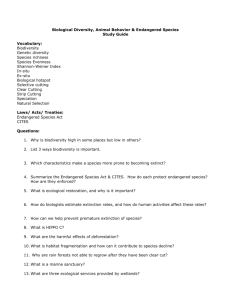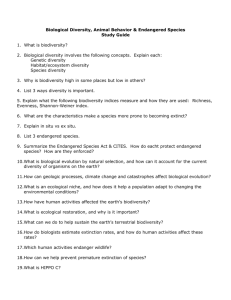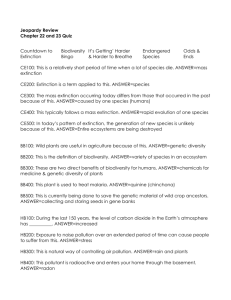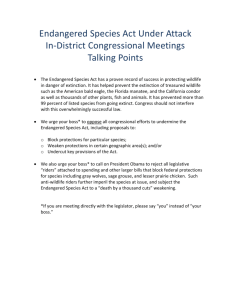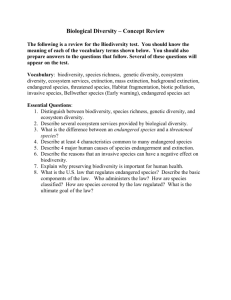Biodiversity
advertisement
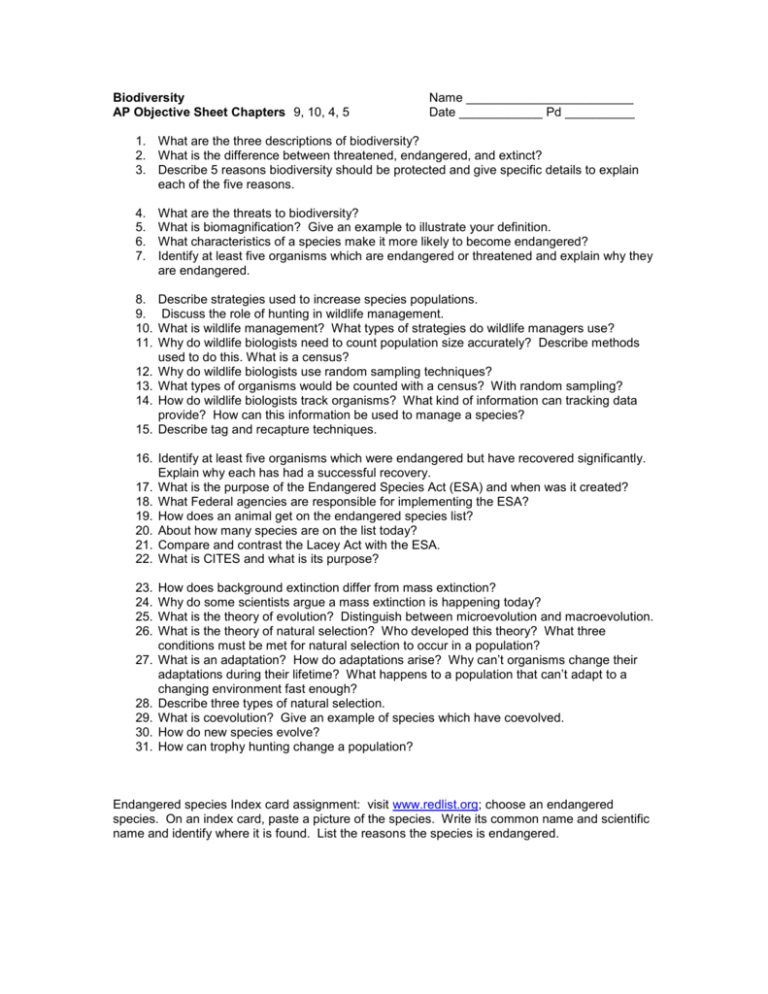
Biodiversity AP Objective Sheet Chapters 9, 10, 4, 5 Name ________________________ Date ____________ Pd __________ 1. What are the three descriptions of biodiversity? 2. What is the difference between threatened, endangered, and extinct? 3. Describe 5 reasons biodiversity should be protected and give specific details to explain each of the five reasons. 4. 5. 6. 7. What are the threats to biodiversity? What is biomagnification? Give an example to illustrate your definition. What characteristics of a species make it more likely to become endangered? Identify at least five organisms which are endangered or threatened and explain why they are endangered. 8. 9. 10. 11. Describe strategies used to increase species populations. Discuss the role of hunting in wildlife management. What is wildlife management? What types of strategies do wildlife managers use? Why do wildlife biologists need to count population size accurately? Describe methods used to do this. What is a census? Why do wildlife biologists use random sampling techniques? What types of organisms would be counted with a census? With random sampling? How do wildlife biologists track organisms? What kind of information can tracking data provide? How can this information be used to manage a species? Describe tag and recapture techniques. 12. 13. 14. 15. 16. Identify at least five organisms which were endangered but have recovered significantly. Explain why each has had a successful recovery. 17. What is the purpose of the Endangered Species Act (ESA) and when was it created? 18. What Federal agencies are responsible for implementing the ESA? 19. How does an animal get on the endangered species list? 20. About how many species are on the list today? 21. Compare and contrast the Lacey Act with the ESA. 22. What is CITES and what is its purpose? 23. 24. 25. 26. 27. 28. 29. 30. 31. How does background extinction differ from mass extinction? Why do some scientists argue a mass extinction is happening today? What is the theory of evolution? Distinguish between microevolution and macroevolution. What is the theory of natural selection? Who developed this theory? What three conditions must be met for natural selection to occur in a population? What is an adaptation? How do adaptations arise? Why can’t organisms change their adaptations during their lifetime? What happens to a population that can’t adapt to a changing environment fast enough? Describe three types of natural selection. What is coevolution? Give an example of species which have coevolved. How do new species evolve? How can trophy hunting change a population? Endangered species Index card assignment: visit www.redlist.org; choose an endangered species. On an index card, paste a picture of the species. Write its common name and scientific name and identify where it is found. List the reasons the species is endangered. Mon Tue Wed Oct 21 Fri Oct 23 Review Chapter 4 & 5 Case studies HW Objs 1-10 Mon Oct 27 Tue Oct 28 Mon Nov 3 Hand out Lab Stamp Objs 110 HW Objs 1120 Chapter 9 Case studies Tue Nov 4 Wed Oct 29 Tue Nov 11 Chapter 9: background extinction rate biological extinction endangered species HIPPCO precautionary principle threatened (vulnerable) species extinction rate habitat fragmentation Chapter 10: biodiversity hotspots Thur Oct 30 Fri Oct 31 Stamp Objectives HW Objs 2131 Chapter 10 Case studies Wed Nov 5 Review HW: Endangered Species card Mon Nov 10 Thur Oct 22 Thur Nov 6 Wed Nov 12 Fri Nov 7 TEST Lab due All Objs due Endangered species card due Thur Nov 13 Fri Nov 14 commercial forest ecological restoration old-growth forests overgrazing pastures rangelands reconciliation ecology second-growth forests tree plantation (farm) undergrazing wilderness Chapter 4: adaptation adaptive trait background extinction biological diversity biological evolution differential reproduction ecological niche endemic species extinction fossils foundation species generalist species Chapter 5: age structure carrying capacity coevolution commensalism ecological succession environmental resistance inertia interspecific competition limiting factor limiting factor principle mutualism parasitism persistence population population crash population density predation predator-prey relationship primary ecological succession range of tolerance resilience resource partitioning secondary ecological succession

